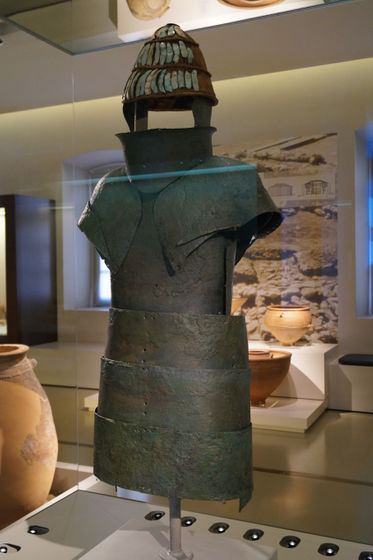Active duty Marines recreate the legendary Trojan War wearing 3,500-year-old 'ancient Greek armor,' proving it is a weapon for real combat

A new paper has been published in which Greek marines were tasked with wearing replicas of
Analysis of Greek prehistoric combat in full body armour based on physiological principles: A series of studies using thematic analysis, human experiments, and numerical simulations | PLOS ONE
https://journals.plos.org/plosone/article?id=10.1371/journal.pone.0301494
In a study published in the open access journal PLOS ONE on May 22, 2024, a research team led by Andreas Floris of the University of Thessaly in Greece examined the practicality of bronze armor excavated from a tomb of the ancient Mycenaean civilization.

This armor was discovered in 1960 near the village of Dendra, a few kilometers from the ruins of the ancient Mycenaean civilization in southern Greece. Experiments using replicas of this 'Dendra armor,' made about 3,500 years ago, showed that it had the mobility to respond to body movements and the defensive power to withstand attacks from weapons of the time. However, it had not been verified whether it could be used in long-term actual combat, so some scholars believe it was made purely for ceremonial purposes.

by
The research team, which began examining the armor of Dendra, first turned to Homer's 'Iliad.' The Iliad is an epic poem based on Greek mythology, and there is a 500-year gap between the time of the Trojan War depicted in the work and the time of Homer. Following the approach of the ancient Greek historian Thucydides , who said that 'the Greek traditions about the distant past contain truth,' the research team positioned the Trojan War in the Iliad as a model for wars in the late Bronze Age.
Next, the research team extracted typical 'start and end times of a day's military activities,' 'activities performed by warriors in a day's battle,' 'amount of food and water consumed by warriors in a day's battle,' 'physical characteristics and level of combat experience of warriors at that time,' 'main types of battles,' and 'weapons, techniques, and movements used by warriors' from the two previous documents that analyzed the Iliad, and based on that, created a Late Bronze Age battle simulation protocol.
Next, the research team recruited volunteers from the Greek Marine Corps, and selected 13 men who were as similar in age and build to the elite soldiers described in the Iliad as possible, and gave them prior training.
The photo below shows Stavros B. Petmezas, a co-author of the paper and a certified martial arts instructor, training the Marines. The training covered a wide range of subjects, including Japanese kendo, martial arts, military strategy lectures, and weapon usage. The training continued until the instructors deemed all participants proficient in using weapons and protective gear.

The armor worn by the soldiers on the day of the experiment was a replica of Dendra's armor, created by professors and students of the Department of Metalworking at Bournville College of Art and Design under the guidance of archaeologist Diana Wardle of the University of Birmingham in the UK. The total weight of the equipment was said to be more than 23 kg.

On the day of the experiment, the participants reenacted a battle based on the aforementioned battle simulation protocol, during a precisely measured battle time from 7:00 to 17:54. Below are artistic photographs of soldiers wearing armor (left) to visually record the experiment, and photos of actual participants conducting the mock exercise (right).

By Andreas Flouris and Marija Marković.
Based on an analysis of the marches and battles described in the Iliad, a simulation of the weather conditions and daylight hours on ancient battlefields, and measurements of the physical strain of participants wearing the Dendra Armor using various sensors, the research team concluded that 'the Dendra Armor was constructed and heavy enough to withstand prolonged combat of up to 11 hours per day, and that wearing the armor while fighting in such combat did not harm the warriors' health.'
The findings also suggest that the ancient Mycenaeans had the technology to manufacture weapons that would enable them to fight for long periods of time, so the authors write in their paper, 'supporting the theory that their weapon-making skills were part of the reason why the Mycenaeans had such a powerful influence in the eastern Mediterranean region.'
Related Posts:
in Science, Posted by log1l_ks







